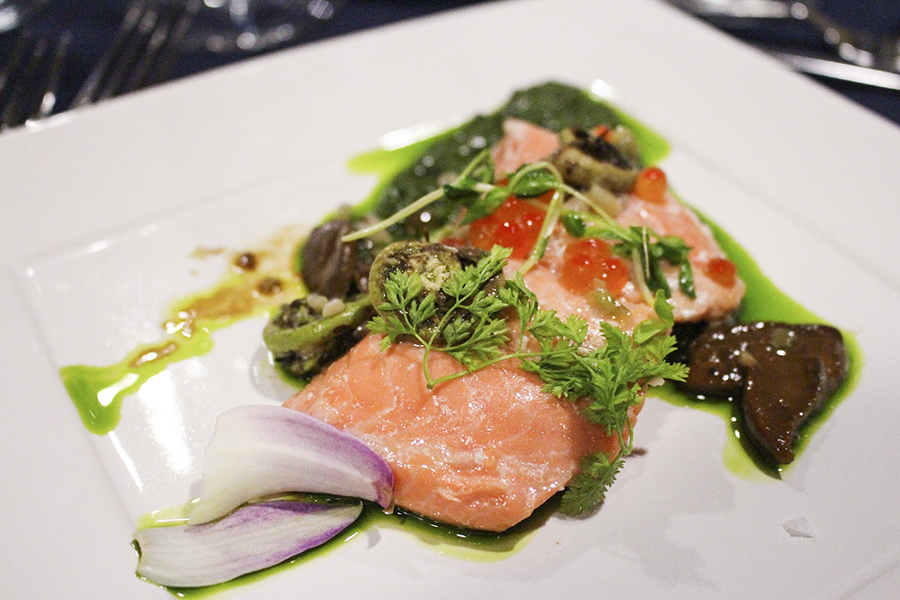The recipe below is taken from “The Silver Oak Cookbook: Life in a Cabaret Kitchen” written by FVCC Executive Chef Howard Karp’s son-in-law, Chef Dominick Orsini. Chef Dominick is the winery chef at Silver Oak Cellars in Napa, California and has been a guest instructor at the Culinary Institute of Montana at FVCC.
I began reading “The Silver Oak Cookbook” a couple months ago and could not put it down. I was blown away by the food and artistic presentation, very beautiful and elegant dishes without being uptight. When Chef Howard suggested that we execute the wild salmon confit for the college’s 50th anniversary Festival of Flavors event, I was thrilled. The salmon is poached instead of seared, giving it a very delicate and sophisticated appearance and texture.
Ingredients:
• 2 c. cold water
• 2 Tbsp. fine sea salt
• 1 Tbsp. finely grated lemon zest
• 1 Tbsp. sugar
• 1 tsp. black peppercorns
• 1 bay leaf
• 2 c. ice water
• 6 wild king salmon fillets with skin, each 3-4 oz., pin bones removed
• 4 c. olive oil
• 1 lb. wild ramps
• 1/2 c. extra-virgin olive oil
• 1/4 tsp. fine sea salt
Brine the salmon: Combine the cold water, salt, lemon zest, sugar, peppercorns, and bay leaf in a small saucepan and heat over high heat, stirring until the salt and sugar have dissolved. Pour into a container large enough to hold the salmon in a single layer. Add the ice water and let cool to room temp. Add the salmon, cover and refrigerate for at least eight hours or overnight.
Cook the salmon: Remove the salmon from the brine and pat dry with paper towels. Pour the oil into a deep skillet and heat over low heat to 120 degrees. This will happen very quickly. Remove the skillet from the burner and place the salmon in the oil. The temp of the oil will drop by 15 to 20 degrees. The goal is to maintain a working temp between 95 and 105 degrees. Do not let the oil get hotter than 110 degrees. If the oil temp drops below 95, return the skillet to the heat; if it rises above 105, remove it from the heat. Set a timer for 30 minutes and maintain the temp the entire time.
Make the pesto: Separate the ramp leaves from the stems and bulbs. You should have about two cups of packed ramp leaves.
Prepare a bowl of ice water. Bring a saucepan filled with water to a boil over high heat. Add the ramp leaves to the boiling water and submerge them with a wooden spoon. Blanch until the leaves are brightly colored and tender, about two minutes. Drain, and immediately plunge the leaves into the ice water to stop the cooking, and drain again.
Squeeze the leaves over a bowl to remove as much water as possible and reserve ¼ cup of the squeezed water.
Coarsely chop the leaves, transfer them to a food processor, and pulse until finely chopped. With the motor running, slowly pour in the olive oil and the reserved water and puree until smooth. Add the salt and pulse to blend. Use the sauce immediately, or transfer to an airtight container and refrigerate for up to two days or freeze for up to one month.
To serve: Place two generous tablespoons of the pesto in the center of each serving plate and spread it into a three-inch circle. Remove the salmon from the oil and blot the skin side of each fillet with a paper towel. Place each piece of salmon, skin side down, in the center of the pesto.
Louis Bertino is an Instructional Assistant at the Culinary Institute of Montana at Flathead Valley Community College. For more information about the program, visit www.culinaryinstituteofmt.com.
